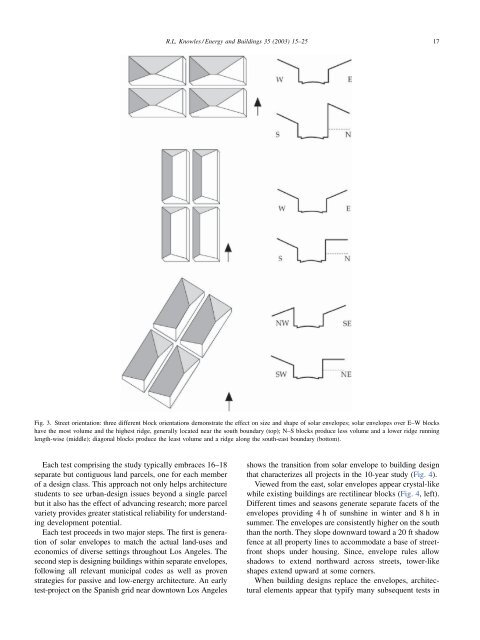The solar envelope: its meaning for energy and buildings
The solar envelope: its meaning for energy and buildings
The solar envelope: its meaning for energy and buildings
You also want an ePaper? Increase the reach of your titles
YUMPU automatically turns print PDFs into web optimized ePapers that Google loves.
Each test comprising the study typically embraces 16–18<br />
separate but contiguous l<strong>and</strong> parcels, one <strong>for</strong> each member<br />
of a design class. This approach not only helps architecture<br />
students to see urban-design issues beyond a single parcel<br />
but it also has the effect of advancing research; more parcel<br />
variety provides greater statistical reliability <strong>for</strong> underst<strong>and</strong>ing<br />
development potential.<br />
Each test proceeds in two major steps. <strong>The</strong> first is generation<br />
of <strong>solar</strong> <strong>envelope</strong>s to match the actual l<strong>and</strong>-uses <strong>and</strong><br />
economics of diverse settings throughout Los Angeles. <strong>The</strong><br />
second step is designing <strong>buildings</strong> within separate <strong>envelope</strong>s,<br />
following all relevant municipal codes as well as proven<br />
strategies <strong>for</strong> passive <strong>and</strong> low-<strong>energy</strong> architecture. An early<br />
test-project on the Spanish grid near downtown Los Angeles<br />
R.L. Knowles / Energy <strong>and</strong> Buildings 35 (2003) 15–25 17<br />
Fig. 3. Street orientation: three different block orientations demonstrate the effect on size <strong>and</strong> shape of <strong>solar</strong> <strong>envelope</strong>s; <strong>solar</strong> <strong>envelope</strong>s over E–W blocks<br />
have the most volume <strong>and</strong> the highest ridge, generally located near the south boundary (top); N–S blocks produce less volume <strong>and</strong> a lower ridge running<br />
length-wise (middle); diagonal blocks produce the least volume <strong>and</strong> a ridge along the south-east boundary (bottom).<br />
shows the transition from <strong>solar</strong> <strong>envelope</strong> to building design<br />
that characterizes all projects in the 10-year study (Fig. 4).<br />
Viewed from the east, <strong>solar</strong> <strong>envelope</strong>s appear crystal-like<br />
while existing <strong>buildings</strong> are rectilinear blocks (Fig. 4, left).<br />
Different times <strong>and</strong> seasons generate separate facets of the<br />
<strong>envelope</strong>s providing 4 h of sunshine in winter <strong>and</strong> 8 h in<br />
summer. <strong>The</strong> <strong>envelope</strong>s are consistently higher on the south<br />
than the north. <strong>The</strong>y slope downward toward a 20 ft shadow<br />
fence at all property lines to accommodate a base of streetfront<br />
shops under housing. Since, <strong>envelope</strong> rules allow<br />
shadows to extend northward across streets, tower-like<br />
shapes extend upward at some corners.<br />
When building designs replace the <strong>envelope</strong>s, architectural<br />
elements appear that typify many subsequent tests in
















